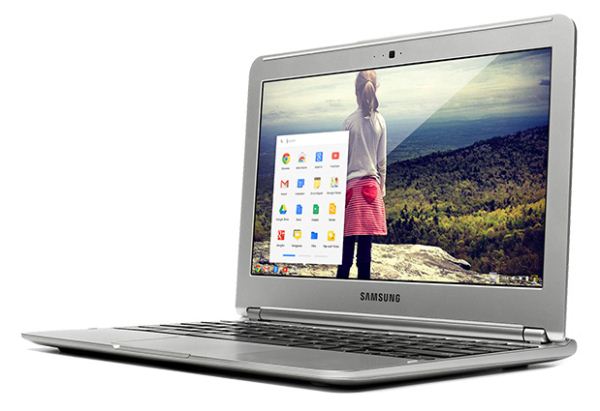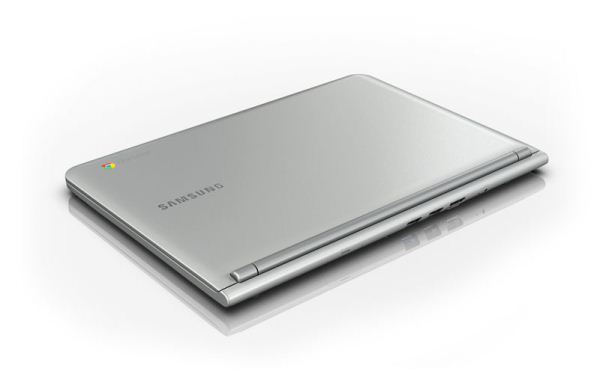Google Reboots The Chromebook: ARM Meets Notebook For $249
by Jason Inofuentes on October 18, 2012 10:11 PM EST- Posted in
- Laptops
- Samsung
- Chrome OS
- Exynos
- Chromebook
- Exynos 5 Dual
Google's been known to throw the spaghetti at the wall to see what sticks. And for every GMail and Android, there's a Wave and Buzz. At best, Google's Chromebook initiative is valiantly clinging to the wall, lost ground not withstanding. Today, they've unveiled their latest Chromebook collaboration with Samsung, and it's frankly quite exciting. The 11.6" notebook weighs in at just 2.5 lbs, and gets to be the first device sporting Samsung's Exynos 5 Dual (5250). Sound familiar? That would be the first ARM Cortex-A15 SoC to show up in a commercially available device, and the first potentially mainstream ARM based PC to hit the market.

The rest of the specs are relatively modest, the 11.6" panel has a respectable 1366x768 resolution, a VGA camera, SD card slot, one each USB 3.0 and USB 2.0 ports, and an HDMI port. Bluetooth and WiFI are built-in, though this generation foregoes the 3G modem of the first Chromebook. Some noise has been made about the quoted 6.5 battery life; we've never taken too much stock in PR provided data. The Cortex-A15 can be a power hungry SoC when stressed, and there's no details on battery capacity, so we'll have to handle the hardware ourselves to size up the battery life.
The SSD is a zippy but small 16GB, but local storage isn't really the point of a cloud-centric Chromebook. And to help allay storage fears, Google's including 100GB of Google Drive capacity for 2 years, with the the purchase of the $249 laptop. That additional cloud storage sweetens the value of the device, too; paying for the service out of pocket would cost $120 over the two year span. So, is this the Chromebook that will finally win us over? We'll find out soon, preorders start today, and sales start Monday.
Update: Turns out a 3G option is available, though unannounced. Service is included in the cost of the device for 2-years, up to 100MB a month, and is provided by Verizon. The 3G SKU will cost you $329, and is available for pre-order now.
Also, I misspoke on the matter of this being the first ARM based PC, I hope the edit adds some clarity.
Source: Google

















50 Comments
View All Comments
bupkus - Friday, October 19, 2012 - link
"There were the Z-80 personal computers (Sinclair Spectrums), there were Commodores and plenty of others."But could they play Angry Birds?
boblabola - Friday, October 19, 2012 - link
http://acorn.chriswhy.co.uk/docs/Mags/PCW/PCW_Sep9...http://acorn.chriswhy.co.uk/docs/Acorn/PR/A4_Launc...
It could have been much better. A colour screen would have been nice.
http://en.wikipedia.org/wiki/RISC_OS
bupkus - Friday, October 19, 2012 - link
Wow, did I ever get a temporal flashback to undergrad days looking at that pdf.bupkus - Friday, October 19, 2012 - link
Dependence on wi-fi.Penti - Friday, October 19, 2012 - link
It would be half decent if you could actually run Android apps on the platform. Would allow some productivity, entertainment, more games and better offline / poor connection use. Configuration as a thin client (Citrix/RDP/VNC/PCoIP) should be easy and straight forward for corporate use. At this hardware price, with full feature GNU/Linux browser with Flash player it could be a halfway-decent as a light machine for consumers. You miss a lot of entertainment and features by not allowing Android apps though. Why wouldn't I want to sync some of my Spotify playlist to this device and why wouldn't I want to use the Android streaming apps from all the services around which does much more than their Flash Player sites (if they even allow you in with a Chromebook). It's for running web-apps but just connection issues and DRM makes that not such much of a proposition. When already running a Linux kernel it's not even that hard to merge it with Android. It's not enough to just be different to Android here, some wider software support is needed. I would love to have webapps for most stuff so I just log in and continue from where I was but that won't happen in full.Adding X11 to Android to run Chromium etc and call it Chrome OS would be possible. Could be a great platform for the web, web apps, consuming multimedia etc.
Mugur - Saturday, October 20, 2012 - link
Correct.Penti - Monday, October 22, 2012 - link
Sensible comment.HisDivineOrder - Friday, October 19, 2012 - link
After the two years, you have to pay $60 per year to keep that 100gb you'll need since the thing is lacking in capacity.Yeah, thanks, but no thanks.
Zink - Friday, October 19, 2012 - link
1. Adding a 32GB SD card is $202. The other way to look at is you're getting 100GB of cloud storage included in the price. $250 is a great price for just the hardware.
$250 - $120 = $130 for A15, USB 3.0 etc.
3. After 2 years just use whatever cloud storage you already have. Skydrive, dropbox etc. will all work on it just like they do on Windows 8 and iOS devices.
zappb - Friday, October 19, 2012 - link
none of the images show up for me, could be just me (in the gallery)